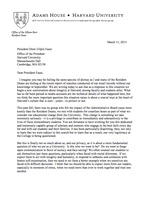“There was kind of a demand that everything be bureaucratized and centralized,” said Stephen A. Mitchell, a professor of Scandinavian and folklore who served as the Master of Eliot House from 1991 to 2000.
In a 1994 report, a committee composed of faculty and administrators clarified the role of the senior tutor as an administrator called on to enforce academic policy in a “uniform fashion” while reporting directly to the Dean of the College.
The report, whose recommendations were largely embraced by a vote of the faculty, elaborated a clear standard for the division of duties between senior tutors and Masters.
“The Master is responsible for the House as a whole and the community it creates; the [Senior] Tutor for the welfare of individual students resident within the House,” the report stated.
While not inherently unreasonable, this strict separation of roles could damage the relationship between Tutors and Masters when taken to extremes, Mitchell said, potentially contributing to a “perception that somehow House Masters were meant to bribe students with food and drink at receptions...and the intellectual, specific student welfare was the responsibility of the resident dean.”
According to former Leverett House Master John E. Dowling ’57, the creation of new deanships and offices outside of the Houses drove this trend.
“There’s no question that University Hall has taken a lot of the responsibility of running a House from the Masters and assumed it for University Hall, and I don’t think that’s a good thing frankly,” Dowling said.
However, this greater oversight has not always translated to close relationships between resident deans and top administrators, some said.
“Because of the nature of how this year has been, I just haven’t gotten to know [Dean of the College Evelynn M. Hammonds] as an academic in the way I would actually like to,” said Cabot House Resident Dean Emily W. Stokes-Rees, adding that her interactions with the dean in the past year have been limited primarily to formal Ad Board meetings.
But even in a more typical year, Stokes-Rees said, heavy workloads on both ends would likely make frequent contact impractical.
“Just in terms of the things she deals with in her day-to-day work, I think it would be unreasonable with the amount that she has to do and the amount that we have to do that we would be corresponding all the time,” Stokes-Rees mused, adding that she interacts much more frequently with some of Hammonds’s associate deans.
Of the 13 resident deans in upperclassman Houses, only Howell and Stokes-Rees agreed to be interviewed for this story. The other 11 declined or did not respond to requests for comment on this story.
A MORE DIVERSE SET OF CHARGES
Some point to the growing diversity of the student body to explain the changed role of the resident dean.
Efforts in the past few decades to broaden racial, gender, socioeconomic, and geographical representation at the College have brought to Harvard a more heterogeneous student body with a more varied background, Dingman said. These students require more attention to guide them through college life, he added, in turn demanding more time from administrators in the Houses.
Read more in News
Late Night in the SquareRecommended Articles
-
Senior Resident Dean Critiques Administrators' ActionsSenior Resident Dean Sharon L. Howell became the first of Harvard’s resident deans to publicly challenge the way that administrators handled their covert search of resident deans’ email accounts last fall and the fallout since the search came to light on Saturday.
-
 Sharon Howell's Letter to Faust Addressing the Secret Email Search
Sharon Howell's Letter to Faust Addressing the Secret Email Search -
After Forwarding Advising Email, Resident Dean Threatened with Severe SanctionsThe Harvard administration threatened to severely sanction a resident dean who shared with two students an internal email advising Administrative Board members on how to counsel undergraduates implicated in the Government 1310 cheating case, four College administrators said Monday.
-
Deans' Design Challenge to Address Growing PopulationWith the world’s population expected to grow exponentially in coming years, the Harvard Innovation Lab is turning to students for solutions to the sociopolitical and environmental problems that population expansion may pose.
-
 Committee Recommends Changes to Resident Dean Position
Committee Recommends Changes to Resident Dean Position -
Semester Brings New Name, Clarifications to Resident Dean PositionThe recommendations were the work of an FAS committee that was convened last summer to review the resident dean position.













